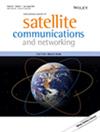Time and phase alignment of distributed gateways: Theoretical analysis and experimental demonstration
IF 1.6
4区 计算机科学
Q3 ENGINEERING, AEROSPACE
International Journal of Satellite Communications and Networking
Pub Date : 2023-09-24
DOI:10.1002/sat.1500
引用次数: 0
Abstract
Summary Very high throughput satellite systems have recently been developed to offer high‐speed connectivity, especially in remote areas, planes, and ships. The high data rates can be achieved by using a multibeam approach with an aggressive reuse of the available frequency resources. Due to the high number of user beams, the system must support a large aggregated bandwidth. Multiple‐gateway architectures are a necessary solution to sustain the immense bandwidth requirements. Multiple‐input multiple‐output (MIMO) feeder links have been proposed to address the ground segment design challenges of multiple‐gateway architectures. The deployment costs and the link availability performance can in particular benefit from this approach. However, to coordinate the operation of multiple gateways, high precision time and phase synchronization is necessary. In this paper, the effect of time and phase misalignment in MIMO feeder links is studied. The performance limitation due to imperfect time and phase distribution is analyzed. Synchronization via optical fiber is considered in this study. The accuracy of time distribution was verified through laboratory measurements. The impact of the residual timing error on the achievable system bandwidth was assessed. Results showed that several GHz of bandwidth can be supported. On the other hand, a recently proposed phase synchronization approach is considered as a promising candidate for MIMO feeder links. Its phase stability performance is assessed, and it is emphasized that requirements in terms of link outage are fulfilled.分布式网关的时间与相位对准:理论分析与实验论证
高通量卫星系统最近被开发出来,以提供高速连接,特别是在偏远地区、飞机和船舶上。高数据速率可以通过使用多波束方法实现,并积极重用可用的频率资源。由于用户波束数量较多,系统必须支持较大的聚合带宽。多网关架构是维持巨大带宽需求的必要解决方案。多输入多输出(MIMO)馈线链路已被提出,以解决多网关架构的地面段设计挑战。部署成本和链路可用性性能尤其可以从这种方法中获益。然而,为了协调多个网关的运行,需要高精度的时间和相位同步。本文研究了MIMO馈线链路中时间和相位失调的影响。分析了由于时间和相位分布不完善导致的性能限制。本研究考虑光纤同步。通过实验室测量验证了时间分布的准确性。评估了剩余定时误差对可实现系统带宽的影响。结果表明,该系统可支持数GHz的带宽。另一方面,最近提出的相位同步方法被认为是MIMO馈线链路的一个有希望的候选方法。对其相位稳定性能进行了评价,强调在链路中断方面满足要求。
本文章由计算机程序翻译,如有差异,请以英文原文为准。
求助全文
约1分钟内获得全文
求助全文
来源期刊
CiteScore
4.10
自引率
5.90%
发文量
31
审稿时长
>12 weeks
期刊介绍:
The journal covers all aspects of the theory, practice and operation of satellite systems and networks. Papers must address some aspect of satellite systems or their applications. Topics covered include:
-Satellite communication and broadcast systems-
Satellite navigation and positioning systems-
Satellite networks and networking-
Hybrid systems-
Equipment-earth stations/terminals, payloads, launchers and components-
Description of new systems, operations and trials-
Planning and operations-
Performance analysis-
Interoperability-
Propagation and interference-
Enabling technologies-coding/modulation/signal processing, etc.-
Mobile/Broadcast/Navigation/fixed services-
Service provision, marketing, economics and business aspects-
Standards and regulation-
Network protocols

 求助内容:
求助内容: 应助结果提醒方式:
应助结果提醒方式:


